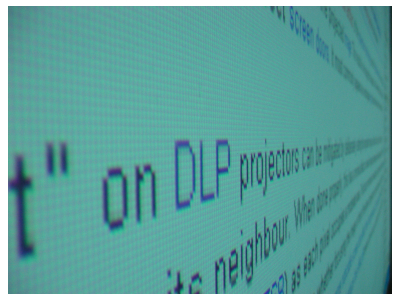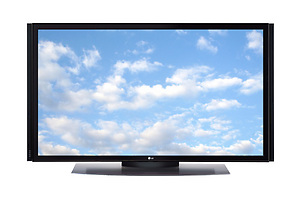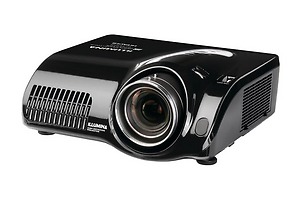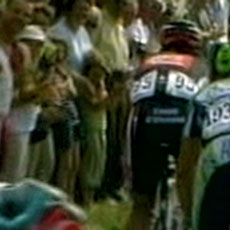The Technology
While each of the common HDTV technologies, LCD, plasma, and DLP, has a group of supporters who consider it to be the best, in reality technology has improved greatly for each in recent years. Along with improvements have come both high end models that usually address traditional weaknesses in the underlying technology and lower end models that usually address some, but aren't able to include many advanced features. Often the availability of important features is dictated by price more than anything else.
LCD
 LCD is the hottest, and arguably the fastest developing HDTV technology right now. At the low end LCD HDTVs offer reasonable prices for moderate screen sizes. At the high end there are LCD models that compete with the best plasma models, both in terms of features and price. Watch out for LCD's infamous "Screen Door Effect," which is generally only visible in fairly large models. The Screen Door Effect occurs when the small size of LCD pixels results in a visible grid of spaces in between them.
LCD is the hottest, and arguably the fastest developing HDTV technology right now. At the low end LCD HDTVs offer reasonable prices for moderate screen sizes. At the high end there are LCD models that compete with the best plasma models, both in terms of features and price. Watch out for LCD's infamous "Screen Door Effect," which is generally only visible in fairly large models. The Screen Door Effect occurs when the small size of LCD pixels results in a visible grid of spaces in between them.
The image on the right shows an example of the screen door effect. Don't expect to see anything this dramatic on an actual HDTV.

Plasma
Despite LCD's recent dominance of the retail market, there are still improvements being made in plasma technology. Although not competitive at the low end of the market, many people find them attractive for their wide viewing angle and good contrast.DLP
 DLP, or Digital Light Processing, uses an array of mirrors to reflect light on the screen. This of course means all DLP HDTVs are rear projectors. Unlike Plasma or LCD models, a DLP HDTV can't be hung on a wall. If you're looking for a large screen at a relatively modest budget you should seriously consider DLP. One complaint with some DLP HDTVs is something called the Rainbow Effect, which results from the way most DLP TVs produce color by passing the light to be reflected off the DLP chip through a filter on a spinning color wheel. The effect can be minimized either by using separate DLP (mirror) chips for each color or the more common method of using a color wheel with 6, 7, or 8 segments (color filters). Some people don't notice this affect even with older DLP TVs.
DLP, or Digital Light Processing, uses an array of mirrors to reflect light on the screen. This of course means all DLP HDTVs are rear projectors. Unlike Plasma or LCD models, a DLP HDTV can't be hung on a wall. If you're looking for a large screen at a relatively modest budget you should seriously consider DLP. One complaint with some DLP HDTVs is something called the Rainbow Effect, which results from the way most DLP TVs produce color by passing the light to be reflected off the DLP chip through a filter on a spinning color wheel. The effect can be minimized either by using separate DLP (mirror) chips for each color or the more common method of using a color wheel with 6, 7, or 8 segments (color filters). Some people don't notice this affect even with older DLP TVs.

Front Projectors
Although not technically HDTVs since they don't include a tuner, front projectors are becoming a popular way to increase screen size without a corresponding increase in price. Both DLP and LCD front projectors are fairly common, and use the same A/V connections that standard HDTVs do. Image quality depends on a number of factors including the projector itself, the light level in the room (front projectors require fairly low lighting), and the screen you're projecting the image on.| * For more information about specific models of flat panel HDTV or projector you can visit the categories for each in our Hardware section. |
HDTV Technology
Despite the marketing focus on core technologies like LCD or Plasma, much of the technology you need to consider isn't specific to any one type of display. While each has distinct advantages and disadvantages, many of the features that will have the greatest impact on your viewing experience are found in a wide range of displays, and often vary more by price than anything else. As with most consumer electronics, the quality of certain features varies more by line than individual model. There's often a divide between features offered on the most expensive model among a company's entry level offerings and those offered at the lowest levels of their flagship line.
| * If you're getting your first HDTV you may be surprised at how much better the picture is with little or no increase in size over your current TV. While it's nice to have the biggest screen possible, you may find that your money is better spent on good scaling and deinterlacing rather than screen real estate. |
Scaling
The quality of your HDTV's scaler can be the difference between a good picture and a great one. With the combination of 1080p, 1080i, 720p, and even standard definition video you're likely to encounter, your HDTV's scaler is likely to see regular, probably daily use. As noted in the previous section, make sure to find out what kind of quality you get from video from both SD video and HD video that's not in the HDTV's native resolution.| * If you're considering a HDTV with a resolution other than 1280x720 or 1920x1080 all incoming video will have to be scaled because those are the only HD resolutions used for either broadcast or next-generation DVD formats. |
Deinterlacing
While progressive video offers improved picture quality than traditional interlaced analog television, it's also important to consider how traditional interlaced TV signals are displayed. While deinterlacing is really best accomplished before the video is sent to your TV, this isn't always possible, particularly when live TV viewing is involved. The three images below are from the same source, deinterlaced three different ways. Ideally your HDTV will have multiple strategies for deinterlacing, depending on whether the image is moving or not.


| * If you're buying a progressive scan (720p or 1080p) HDTV make sure to evaluate its performance with interlaced video. If possible you should test both SD and HD interlaced video. Make sure to look at some high motion video, and pay particular attention to vertical or near vertical lines, as that's where you'll see the most obvious deinterlacing artifacts. |
Refresh Rate
In addition to the resolution of a single frame (width x height), video has a temporal resolution or framerate. Although video encoding standards and existing video generally limits us to no more than 60fps, some HDTVs are capable of refreshing the screen twice that often at 120Hz. The importance of 120Hz is that it's a good framerate for 24fps film to be displayed at (better than 60Hz). In addition to the 120Hz refresh you need to make sure the HDTV has some type of special mode to handle film (24p) content. Depsite this high refresh rate, some LCD HDTVs have problems keeping up with all the changes on the screen in high motion video.| * For HDTVs with a 120Hz refresh rate always try to test quality on film (24p) sources. For LCD HDTVs make sure to check for lag during high motion scenes like full screen explosions. |
Next: The Afterdawn HDTV Buyer's Guide
Version History
v1.0 2007.12.24 Originally published by Rich "vurbal" Fiscus
v1.0.1 2007.12.27 Formatting updated by Rich "vurbal" Fiscus

